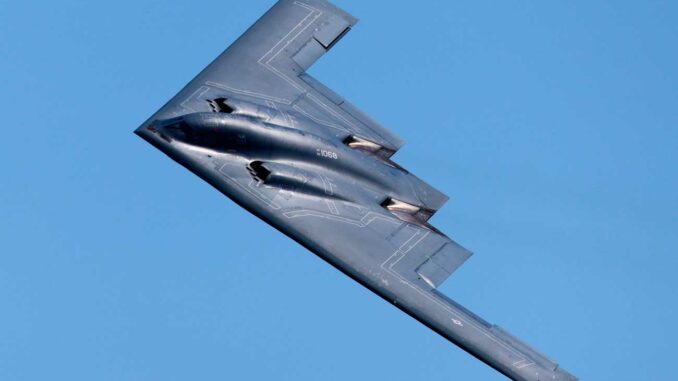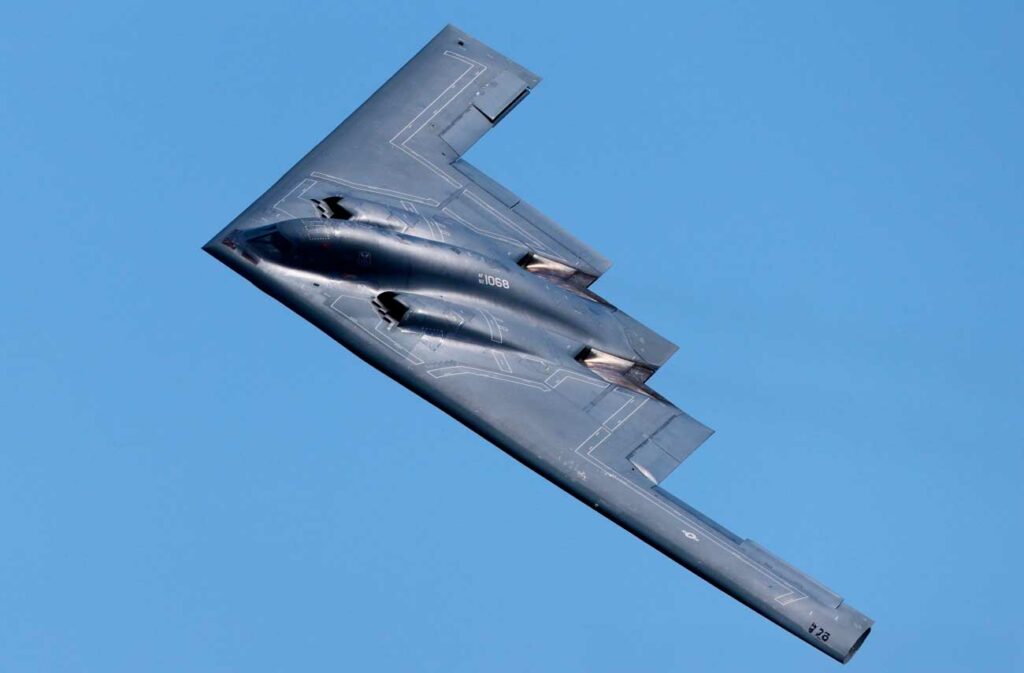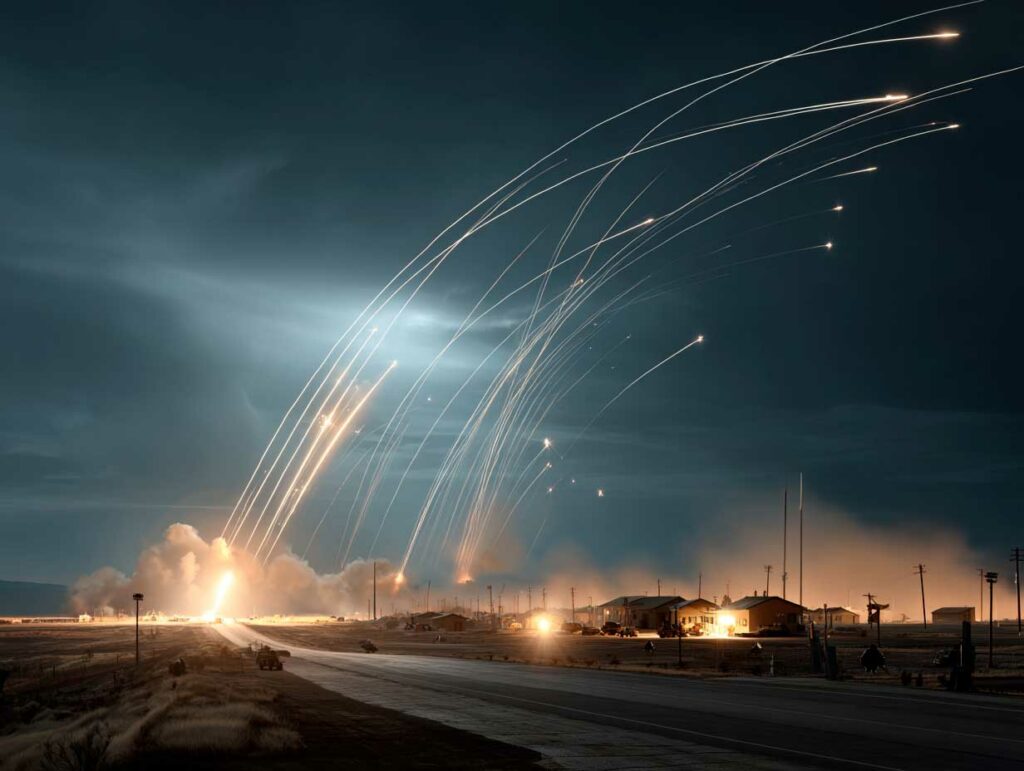
Technical analysis of the B-2/Tomahawk strikes of June 21, 2025 in Iran, reactions, regional consequences, and operational uncertainties.
On June 21, 2025, the United States carried out high-intensity air strikes against three key sites in Iran’s nuclear program: Fordow, Natanz, and Isfahan. Using B-2 Spirit stealth bombers and Tomahawk cruise missiles, the operation was aimed at thwarting a program deemed threatening by Washington and Jerusalem. President Donald Trump described the action as a “spectacular military success”, claiming that the facilities had been “completely and utterly destroyed”, but did not specify the actual damage. Iran, for its part, confirmed the attacks without acknowledging any significant damage, stating that its nuclear program would continue and warning of a possible severe response.
The strike: technical characteristics and operational sequencing
The US operation on June 21, 2025, was launched between 2:30 and 3:00 a.m. local time to maximize the element of surprise and limit civilian casualties. It involved two components: stealth strategic bombers and long-range strike vectors. This attack, planned with the Israeli General Staff, was a continuation of the Israeli strikes that began on June 13, aimed at disrupting Iran’s nuclear infrastructure.
The first wave involved six B-2 Spirit aircraft taking off from Whiteman Air Force Base in Missouri. These aircraft dropped twelve GBU-57 Massive Ordnance Penetrator (MOP) bombs, including six on Fordow, four on Natanz and two on Isfahan. Designed for deep targets, each MOP weighs 13,600 kg and can penetrate more than 60 to 90 meters of rock or reinforced concrete before exploding. The targeting of Fordow, an enrichment site protected by layers of concrete and mountains, indicates a direct attempt to neutralize its IR-6 centrifuges.
At the same time, 30 Tomahawk missiles were fired from two Virginia-class submarines positioned in the Sea of Oman. Flying at 880 km/h, these missiles have an effective range of approximately 1,600 km and are capable of striking with accuracy of less than 10 meters thanks to their inertial and GPS guidance systems. The targets included command buildings, laboratories, and logistics warehouses.
The entire operation was based on a stealth entry strategy, making the B-2s difficult to detect by Iranian radar, and multi-vector calibration, enabling several layers of defense to be struck simultaneously. This combination aims to paralyze Iran’s ability to quickly restart its nuclear program.

Operational assessment and damage evaluation
President Donald Trump described the operation as a total military success, claiming that the nuclear sites targeted in Fordow, Natanz and Isfahan had been “completely and totally destroyed .” However, initial analyses, both independent and institutional, strongly qualify this claim.
The International Atomic Energy Agency (IAEA) published an initial report on June 22 indicating no measurable increase in radioactivity in the targeted areas. This is crucial information: it suggests that the reactors or fissile materials were not directly hit, or that the containment structures withstood the strikes. The IAEA nevertheless requested immediate access to the sites to confirm the condition of the sensitive facilities.
On the Iranian side, the Atomic Energy Organization of Iran (AEOI) confirmed the strikes but said that critical areas had been partially evacuated several days earlier, following warnings from Israel. It claims that the 60% uranium enrichment program has not been affected and is continuing in Natanz and Isfahan.
Data from commercial satellite imagery (Maxar, Planet Labs) reveals significant structural damage on the surface: collapsed hangars, craters several meters deep, and damage to ancillary infrastructure. However, no assessment at this stage can confirm that the underground tunnels at Fordow—located more than 80 meters below limestone—were completely hit by the GBU-57s.
Experts believe that the tactical effects are undeniable, particularly in terms of logistics and temporary production. However, the strategic effect on the enrichment cycle remains uncertain. It will probably take 10 to 15 days to obtain verifiable information on the condition of the centrifuges, power lines, and enriched uranium stocks.
Iranian reaction: stance and potential response
Tehran’s reaction was immediate and multi-pronged, combining aggressive diplomatic rhetoric, conventional military retaliation, and mobilization of its regional network of allies. Iranian Foreign Minister Abbas Araghchi described the US strikes as a “dangerous war” with “eternal consequences”, while asserting that Iran reserved “all options”, including direct retaliation against US interests in the region.
At the same time, Hossein Shariatmadari, an influential advisor to Ayatollah Ali Khamenei, publicly called for strikes against the US Navy in the Persian Gulf and the closure of the Strait of Hormuz, a strategic passage through which approximately 30% of the world’s seaborne oil transits. Such a closure would cause major disruption to global energy flows and an immediate spike in crude oil prices.
On the military front, on June 22, Iran fired between 27 and 30 short- and medium-range ballistic missiles at Israeli territory, targeting sites in Haifa, Tel Aviv, Ashkelon and the Negev region. According to Israeli authorities, 86 people were injured, mainly by shrapnel or during evacuations. The Iron Dome defense system reportedly intercepted nearly 70% of the projectiles.
At the same time, Iran activated its indirect warfare capabilities, calling for the mobilization of its affiliated forces in the region:
- The Houthis in Yemen threatened to attack US ships in the Red Sea, particularly in the Bab el-Mandeb Strait.
- Shiite groups in Iraq announced their intention to target US bases in the provinces of Anbar and Diyala.
On the legal front, Tehran has referred the matter to the United Nations Security Council, accusing Washington of violating Iranian sovereignty and threatening international peace, and has called for official condemnation. This multidimensional response confirms that Iran will not limit its response to conventional military logic, but will adopt an asymmetrical, progressive, and regionalized approach.

Israel’s involvement: stance, coordination, and activities
The State of Israel played a central role in triggering and planning the operation, with a first wave of air strikes launched on June 13, 2025, eight days before the US intervention. These attacks targeted Iranian nuclear and military facilities in Natanz, Fordow, Isfahan, and Qom, marking an escalation in the Israeli-Iranian confrontation. Prime Minister Benjamin Netanyahu hailed the US response as a “historic turning point”, asserting that the doctrine of “peace through strength” had been fully embraced by the Trump administration.
According to Israeli military sources, the Israeli strikes used Delilah air-to-ground missiles and GBU-28 penetrator bombs, guided by data collected by spy satellites and Heron TP drones operating from Iraqi Kurdistan. The attack on Qom reportedly caused several civilian casualties, including the death of a 16-year-old teenager, according to Iranian media. This collateral damage fuels Tehran’s rhetoric about the illegitimacy of the aggression, but has not been confirmed by independent sources.
Netanyahu said that these combined operations would delay Iran’s nuclear program by two to three years, mainly by neutralizing critical infrastructure linked to advanced enrichment (IR-6 and IR-8). This time gain is part of Israel’s strategy of denial of capability, which aims not to overthrow the Iranian regime, but to make the cost of accessing nuclear weapons prohibitive.
The close coordination between the Israeli and US armies resulted in real-time intelligence sharing, the synchronization of engagement windows, and the pooling of priority targets. This operational cooperation was jointly led by CENTCOM and IDF Southern Command, with support from Mossad for strategic intelligence. This level of coordination reinforces the message sent to Iran: any move toward nuclear weapons will be met with a swift and targeted multilateral response.
International and regional reactions
The series of US and Israeli strikes against Iranian nuclear sites prompted immediate and concerned reactions from international institutions and regional actors. The UN Secretary-General, António Guterres, expressed grave concern over what he called a dangerous escalation, warning of “catastrophic consequences for the stability of the Middle East.” He called on all parties to show restraint and avoid a regional conflagration that could affect several theaters simultaneously.
The International Atomic Energy Agency (IAEA), which monitors Iran’s nuclear activities, said it had not detected any unusual changes in radioactivity at the Fordow, Natanz and Isfahan sites. This finding tends to confirm that fissile material stocks have not been directly affected, or that the containment facilities have fulfilled their role. However, the agency has requested emergency access to conduct its own on-site inspections.
In the Arabian Peninsula, Iran-backed Houthi rebels in Yemen threatened to attack US ships in the Red Sea if the strikes continued. The statement was reported by Al-Masirah, the movement’s official channel, referring to naval and commercial targets in the strategic straits of Bab el-Mandeb and the Gulf of Aden. This threat illustrates Tehran’s use of proxy forces to widen the theater of confrontation.
In addition, neighboring countries such as Iraq, Syria, Lebanon, and Jordan have expressed fears of increased regional destabilization. Iraqi officials have highlighted the risk of their territory being used as a base for US operations, while Damascus has denounced a violation of international law that could rekindle internal tensions in a Syria still in reconstruction. Humanitarian organizations in the region are warning of a resurgence of migration flows, particularly from the Iranian border areas, if the conflict spreads.
Diplomatic and legal aspects
The US operation on June 21, 2025 raises many constitutional and diplomatic questions in the United States. The Trump administration has stated that the series of strikes was not intended to overthrow the Iranian regime, but was aimed solely at neutralizing military-related nuclear infrastructure. According to the White House, the action was carried out under presidential prerogatives in matters of national security and therefore did not require prior approval by Congress or a formal declaration of war.
However, this legal position triggered immediate criticism within Congress. Several Democratic lawmakers questioned the legality of the intervention. Alexandria Ocasio-Cortez, a leading figure in the progressive wing, raised the possibility of impeachment, arguing that the president had exceeded his constitutional powers. She denounced a large-scale military operation without parliamentary debate or bipartisan consultation.
Other Democrats, such as Jim Himes and Hakeem Jeffries, also expressed legal skepticism, pointing to a violation of the War Powers Resolution Act of 1973, which requires formal notification of Congress within 48 hours in the event of military engagement. These elected officials believe that the administration acted in a legal vacuum, without clear justification of an imminent danger to the United States.
Conversely, some Republicans, such as Senator Ted Cruz, fully supported the operation, arguing that Iran posed a direct strategic threat to US allies in the Middle East and that the strikes were not only legal but necessary to preserve regional security.
The Pentagon has announced a press conference on June 22 at 8 a.m. (Washington time). It will be led by Defense Secretary Pete Hagard and Joint Chiefs of Staff Chairman Dan Caine, with the aim of clarifying the legal basis for the operation, its strategic framework, the targets hit, and the prospects for operational follow-up. This communication is considered essential to clarify the contours of the military action and respond to accusations of excessive use of executive power.

Areas of uncertainty and open questions
Despite the scale of the operation and the strong statements from the US authorities, many gray areas remain regarding the concrete and lasting consequences of this military action. Several technical, diplomatic, and strategic issues remain to be clarified.
- Actual level of destruction
The targeted facilities, particularly in Fordow, are known for their extreme depth and fortification, buried under more than 80 meters of rock. GBU-57 bombs are designed to penetrate such structures, but without precise data or international inspection, it is impossible to confirm that underground enrichment capabilities have been destroyed. Partial damage or logistical delays remain plausible but unconfirmed hypotheses. - Nuclear consequences
The current absence of detected radioactivity by the IAEA suggests that storage areas or active production lines were not hit, or that containment systems worked. However, inspections are too recent to rule out delayed contamination or internal damage. - Regional dynamics
Iran’s response—missiles on Israel, threats to the Strait of Hormuz, activation of regional allies (Houthis, Iraqi militias)—confirms a gradual and multidirectional escalation. The conflict could slide into a long-running hybrid war, without direct confrontation but with continuous indirect actions. - Duration of the conflict
If Tehran continues its reprisals and Washington decides on new strikes, the region could become bogged down in a prolonged cycle of escalation/retaliation that would be difficult to contain without external diplomatic mediation (China, Russia, Qatar, etc.). - Political and institutional impact in the United States
The divide between the executive and legislative branches is widening. There is a risk of legal challenges, or even proceedings against the administration, which would weaken its ability to respond strategically in the short term. - Effects on the global economy
The oil markets reacted immediately: Brent crude rose 12% in 24 hours, tensions on futures contracts, and partial mobilization of strategic reserves by certain countries (notably South Korea and Germany). If the Strait of Hormuz were to be closed, more than 17 million barrels per day would be affected, causing a global shock to energy prices and logistics.
This operation symbolizes a strategic shift: combining stealth technologies and deep penetration capabilities to address a nuclear threat. But its real effects remain calibrated, in an already extremely tense regional context. The strategic validity of the action will depend on the assessment of the damage to the Iranian program and the evolution of the response.
War Wings Daily is an independant magazine.